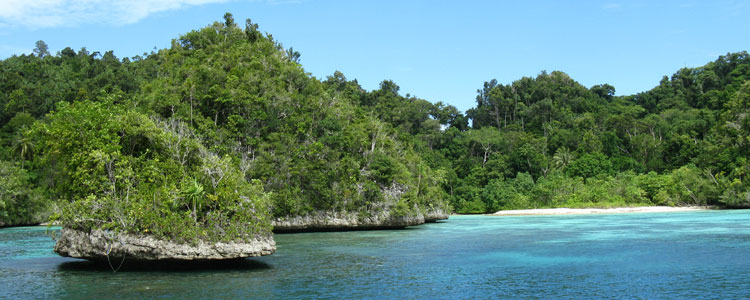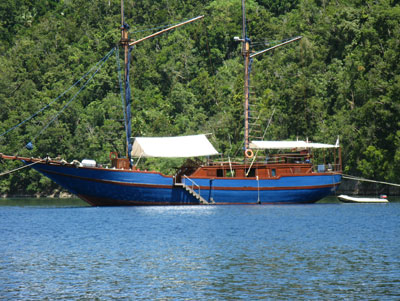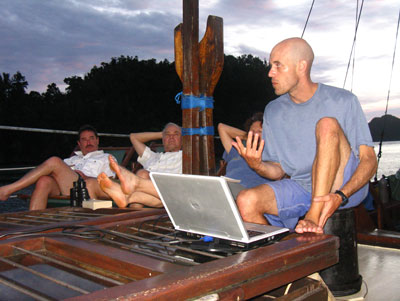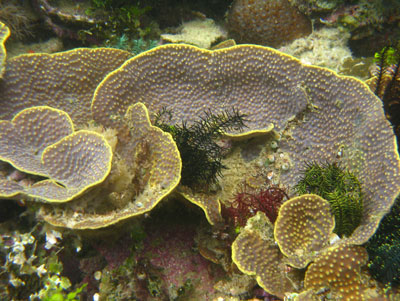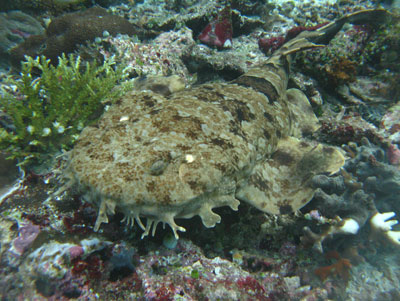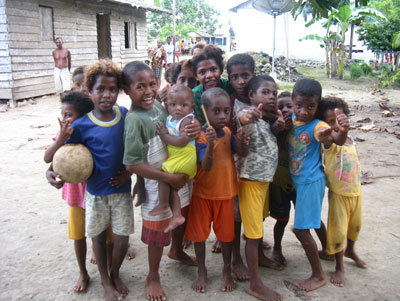Raja Ampat: A diver’s dream destination
by Larry Taylor; Fullerton, CA
There is no doubt about it: the best snorkeling and diving in the world can be found in Raja Ampat. This west Indonesian archipelago contains more marine biodiversity than anywhere else in the world.
In 2002 The Nature Conservancy conducted a scientific survey of the islands, confirming the presence of 537 species of coral and bringing the number of recorded fish species there to 1,074. (One source has recently upped that to nearly 1,300.)
Raja Ampat
My wife, Gail, and I have snorkeled all around the globe. Previously, we thought the best sites were in Palau. Raja Ampat, we decided, was even better.
One of the reasons is the area’s isolation. During our 10-day live-aboard boat trip, we saw no other tourists — no divers, no snorkelers, no anybody other than natives in the few villages we visited.
Located off the northwest tip of the island of New Guinea, Raja Ampat comprises over 1,500 small islands, cays and shoals surrounding four main islands: Batanta, Misool, Salawati and Waigeo.
Most islands are limestone, pockmarked with caves and undercut by wave action. Some are volcanic. All are covered with green growth and small trees and are part of the newly named West Papua province of Indonesia.
Aboard the Shakti
We went to Raja Ampat in late May ’09 on a Wilderness Travel snorkeling expedition. Our group of 11 stayed aboard the Shakti, a double-masted traditional Indonesian craft measuring 36 yards long and eight yards wide. Our cabin, though cramped, was comfortable.
Captain David Pagliari, a Scotsman raised in Hong Kong, maintained a crew of seven.
Our guide, Ethan Daniels, is a marine biologist and an expert on the flora and fauna of the area. Ethan has led several expeditions to Raja Ampat. He would gather us daily during cocktail hour for a lecture on the marine life and geography of the places we would be visiting, with slides to illustrate his talks. During our snorkels, whenever something was spotted he would make sure everyone had seen it.
Our daily routine started with two morning snorkels followed by three in the afternoon. This was supplemented by hikes, cave exploration and bird-watching. Our first snorkel was scheduled around 8:30, so we got up early, seeing brilliant red sunrises, before breakfast at 7.
In the water
After boarding a dinghy, we were taken to spots with colorful descriptive names like Zen Coral Garden West, Monitor Lizard Beach and Guitar Island. We snorkeled along limestone walls with every imaginable type of coral and fish.
In deeper water, we saw large bumphead parrotfish go by in schools as well as solitary blacktip reef sharks. One memorable sight — a school of hundreds of bait fish gliding by with several two-foot-long, black-spotted yellow Oriental sweetlips swimming under them, probably trying to grab a snack.
On shallow reefs, we saw incredible coral gardens below us. Huge plate corals and sweeping soft corals were among every kind imaginable and in greater abundance and more colors than we had ever seen. Living among them were yellow, orange and purple sponges. Like eager students, we were able to identify them from Ethan’s lectures.
At times, we would take drift dives, our dinghy letting us off at the beginning of a tidal passage and the swift water carrying us through — an amusement park ride in the midst of an aquarium. We just let ourselves go with the flow.
A couple of times we entered strange worlds, like the mangrove swamp where cardinalfish lurked in tangled roots and tiny shrimp dug holes in the sandy bottom while goby fish (their roommates) stood watch for predators.
In one grove we took off our fins and stealthily walked through the shallows to a deserted beach. Close to shore was a “nursery” for baby stingrays and reef sharks. Disturbed, the babies fled at our approach, one ray nearly bumping into my shocked wife’s leg.
While leaving the grove, we spotted a shaggy wobbegong shark under a ledge. It looked more like Cookie Monster than a fish.
Adventures and revelations
Each day brought more surprising adventures but none more surprising than our “field trip” to the pearl farm on Waigeo Island. The tour was most interesting, as we saw how oysters were seeded and shucked for pearls. This was also our only shopping stop, with pearl jewelry on display at the end of the tour.
A plus here — our group was given a bag of oyster meat, which the crew made into a delicious treat for dinner.
Following the tour of the facility came one of our trip highlights: snorkeling off the dock in front of the farm. There was no dazzling coral here, just rocky reefs and sandy bottoms, but there were amazing creatures to behold — and without our guides we would have swum past most of them.
The cuttlefish, for example, takes on the color of its surroundings. Its skin can even become spiky to mimic jagged surfaces. The craggy scorpion and stonefish were also difficult to detect, as was the spotted epaulette shark, its coloring, too, blending amazingly with the background. When startled, it walked away on its two lower fins, as it uniquely does.
Particularly good at spotting interesting creatures was our Indonesian guide from the Shakti, Robert Lahenko. He would dive down, then come up and say, for example, “Crocodilefish.” We would look down, then shrug, saying, “Where?” He would go under again and trace its outline with his fingers and — “Voila!” — there it was. He, along with Ethan Daniels, was what made this trip so rewarding.
Something new for us but readily seen here were beautiful nudibranchs. Diver friends have gone deep to see them, but in Raja Ampat they were in shallow waters. Mollusks without shells, nudibranchs (sometimes called sea slugs) are decorated in all ranges of blues, oranges, yellows and reds. We were constantly on the lookout for the one- to two-inch-long creatures found here.
Snacks and meals
When we came in from our afternoon snorkel each day, we had delicious, fresh-from-the-galley baked goods — cinnamon rolls, apple cake, cookies — all made from the German recipes of First Mate Diana “Din” Himmelspach. Conversant in English and the local Indonesian dialect as well as German, Din translated directions for the crew and cooks.
The Shakti had two Indonesian cooks who prepared local foods. While the curry-like dishes were tasty and hearty, they did get a bit monotonous. Lunch and dinner always consisted of white rice and a vegetable plus meat and fish or shellfish. All dishes were sauce based with ginger and local spices. Dessert was fresh fruit.
Breakfast consisted of crêpes and/or eggs and freshly baked bread. A few times, cornflakes were a welcome option. A cooler on deck was open 24 hours a day and was filled with local beer, juices and soft drinks.
Winding down
On our next-to-last day, we anchored off the south side of Gam Island, home to the spectacular Red Bird of Paradise.
We went ashore and took a short hike to a “bird blind,” erected by islanders, to view the birds above. We heard their calls and there they were, high in the treetops. Silhouetted against the sun, the birds were difficult to photograph, but we did see them go through their mating display.
We met villagers who were living much the same way they always had, although we could hear the whir of a generator and saw a TV satellite dish on top of a meeting hall. The people were very friendly, especially the children.
Wilderness Travel (Berkeley, CA; 800/368-2794, www.wildernesstravel.com) schedules four trips a year to Raja Ampat, two in late spring and two in late fall. Prices for 2010 trips start at $5,195 per person, excluding airfare to Jakarta and on to Sorong, where we boarded the boat. (Round-trip airfare from Jakarta to Sorong costs around $350-$550 per person, depending on travel date. Merpati Airlines [www.merpati.co.id] and Lion Air [www.lionair.co.id] offer daily flights.)
To arrange a trip on the boat independently, visit www.shakti-raja-ampat.com (or phone +62 812 44085355).

